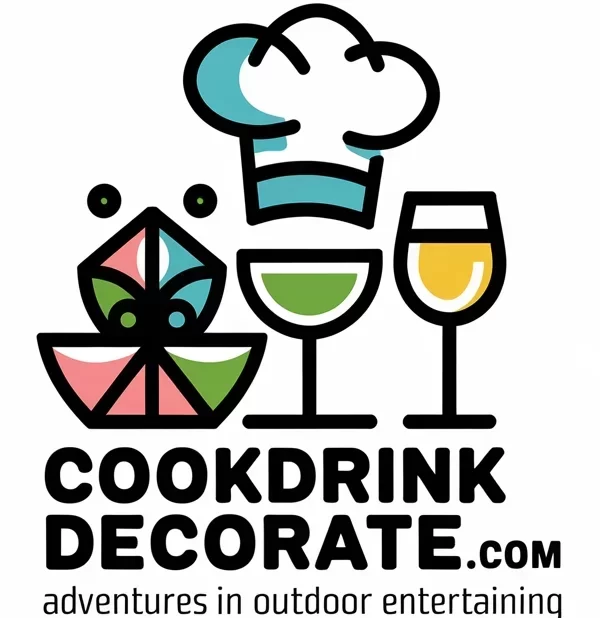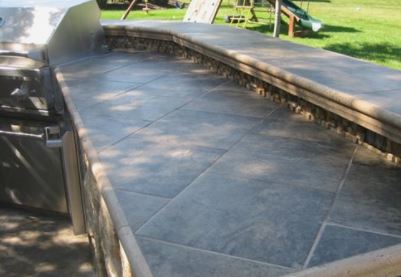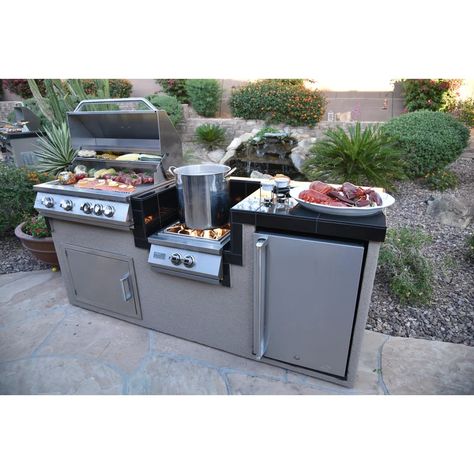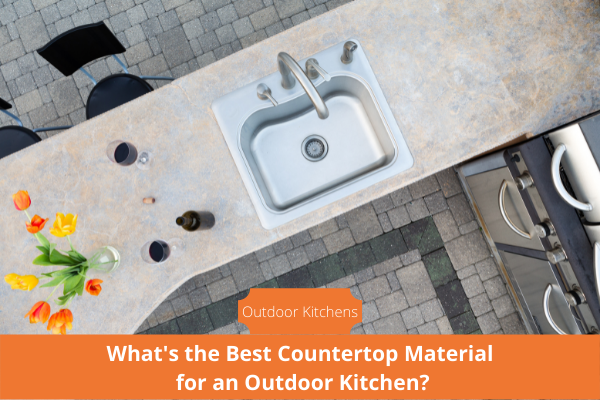Outdoor Flooring Ideas: Creative Ways to Refresh Your Patio or Backyard
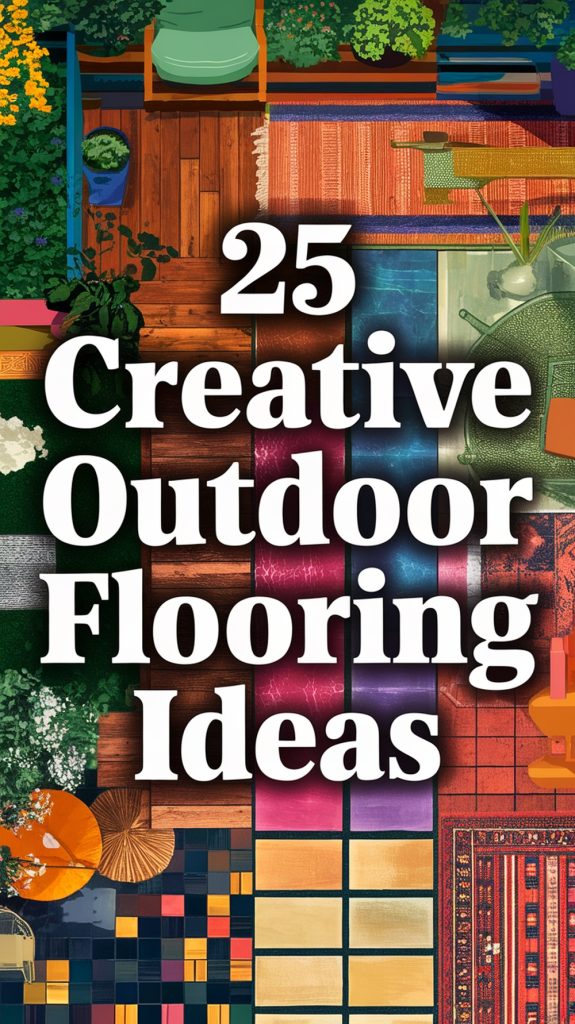
Outdoor Flooring Ideas: Creative Ways to Refresh Your Patio or Backyard
Creating an outdoor space you enjoy starts with the right flooring. You have many outdoor flooring options, from simple patio tiles to more unique materials like pallets and terrazzo, so you can find a style that fits your home and budget. Whether you want something smooth and modern or textured and rustic, there’s something for every need.
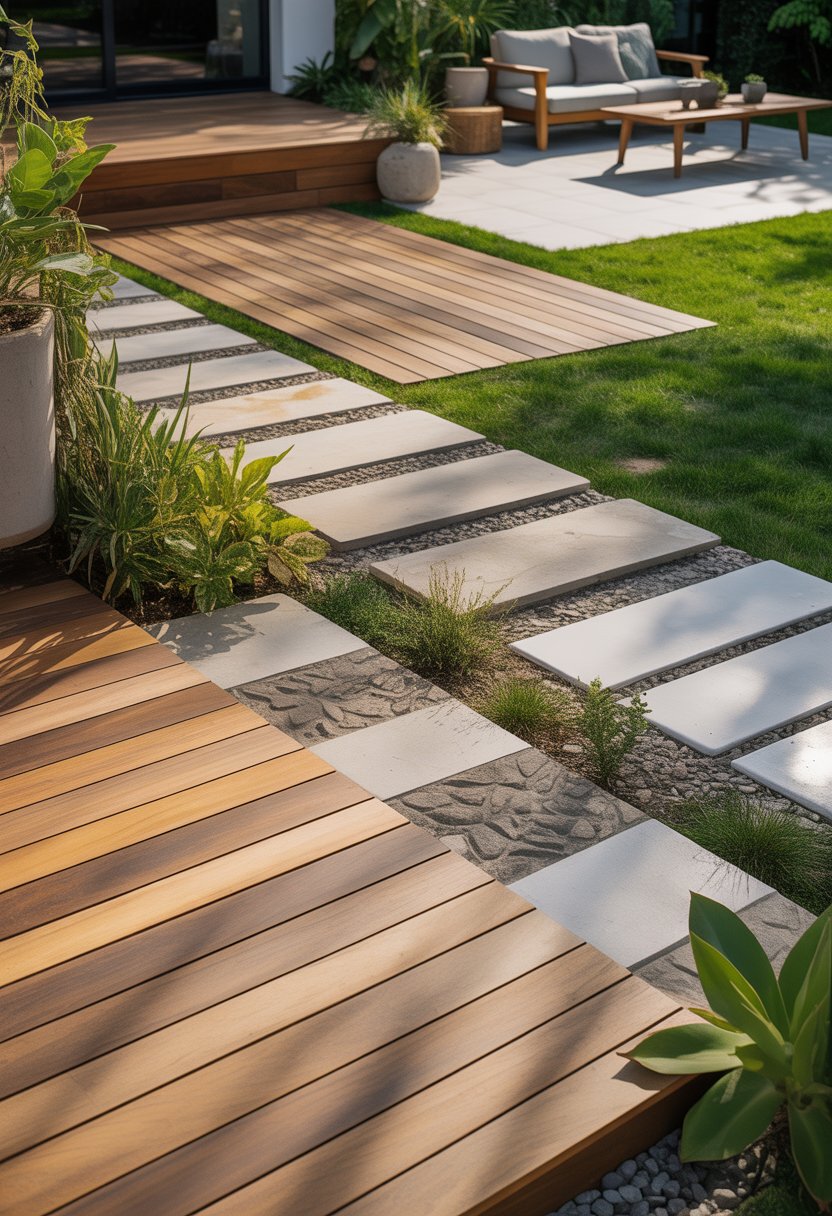
Outdoor floors should handle weather, look good, and be safe to walk on. Some ideas are quite affordable and easy to install, while others offer a more permanent, stylish look. This guide will help you discover different choices so you can make the best decision for your space.
Key Takeaways
- Explore different materials for your outdoor area to match your style and needs.
- Some outdoor flooring ideas are budget-friendly and easy to install.
- Make your outdoor space safer and more comfortable with smart choices.
Patio Tiles
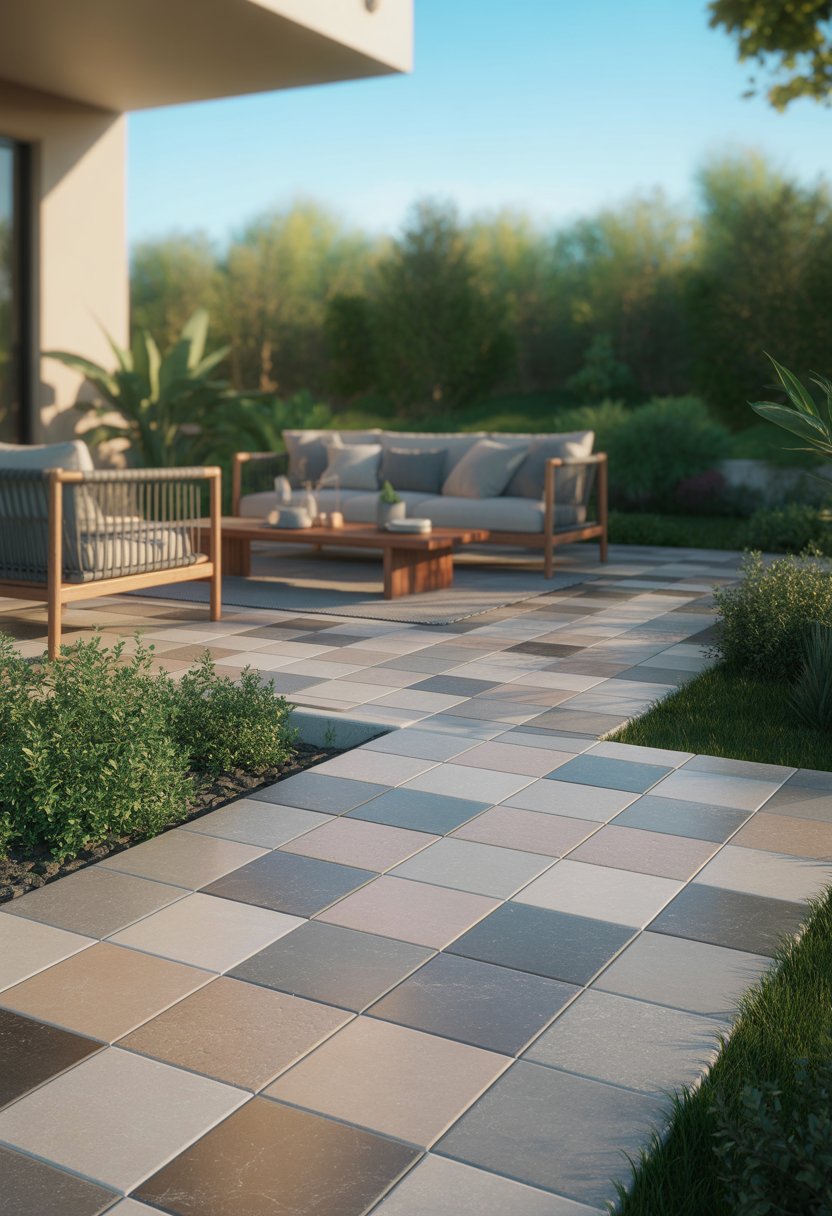
Patio tiles come in many materials, colors, and patterns. They can give your outdoor space a clean, organized look. Most tiles are easy to clean and replace if needed.
Outdoor Patio Tiles Over Concrete Non-Slip
If you want to upgrade a concrete patio, using tiles is a smart option. You can lay most patio tiles right over your old concrete, saving time and effort. Non-slip patio tiles make your space safer, especially when wet or after rain.
Look for tiles made from porcelain, rubber, or textured stone. These types help prevent slips. Many brands make interlocking tiles that snap together and stay in place. Some tiles even come with built-in drainage so water does not pool on the surface.
Here’s a quick list of benefits:
- Easy to install
- Non-slip surfaces reduce falls
- Many color and design choices
- Stays durable in sun and rain
You can mix and match colors or patterns to make simple designs. Make sure to follow the manufacturer’s guide for outdoor use.
Granite Floor Design Outdoor
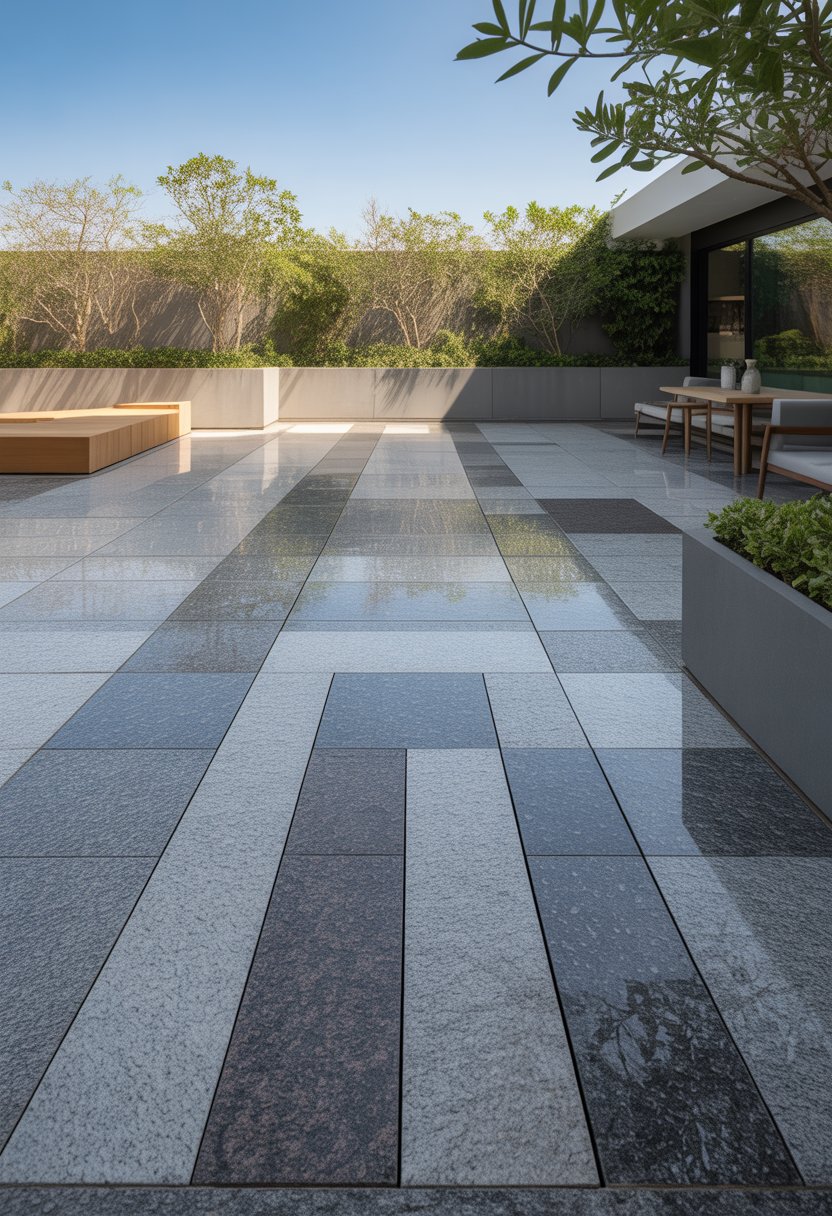
Granite is a strong and beautiful choice for outdoor floors. You can pick from many colors, patterns, and finishes to match your style and needs.
Modern Granite Floor Design Outdoor
A modern granite floor looks fresh and clean. You will often see simple shapes, smooth lines, and large tiles that create a neat look.
Choose a matte or polished finish for a stylish feel. Polished granite reflects sunlight, making your outdoor space bright, while matte finishes are less slippery and safer for wet areas.
You can use a single color for a smooth look or mix a few shades for more interest. Modern designs work well for patios, pool decks, or garden paths. Granite is easy to pair with metal furniture, glass tables, or bright plants, giving your outdoor space a sleek touch.
White Granite Floor Design
White granite adds a bright and clean look to outdoor floors. It makes your space feel more open and fresh.
This color reflects sunlight well, so it helps keep walking surfaces cooler in the summer. You can choose from solid white options, or ones with small black or gray specks for a bit of texture. White granite works well for both shady and sunny spots.
It matches nicely with dark planters, wooden furniture, and green lawns. Because dirt and stains can show easily on white, it is important to sweep and rinse your floor often. Sealing the surface helps stop stains and keeps the white color strong.
Grey Granite Floor Design
Grey granite is a popular pick for outdoor floors because it hides dirt and matches many settings. It comes in many shades, from light silver to dark charcoal.
You can find granite tiles with interesting patterns or use plain grey for a calming look. Grey granite fits many home styles, including modern and traditional. It is easy to match with stone walls, outdoor kitchens, or pool borders.
Grey granite does not fade easily in the sun, and it does not show water spots or dust as much as lighter colors. Regular cleaning helps it stay fresh looking. For extra grip, choose a textured finish, which helps prevent slipping when the floor is wet.
Outdoor Flooring Texture

Texture plays a big part in how your outdoor floors look and feel. It can change how safe a space is and how easy it is to walk on, especially in wet conditions.
Seamless Outdoor Flooring Texture
Seamless flooring has a smooth surface with very few joints or cracks. This type of texture gives your patio or walkway a tidy appearance and makes cleaning easier since dirt can’t get trapped in grooves.
Common types of seamless textures:
- Poured concrete: Looks modern and is easy to wash down with a hose.
- Epoxy coatings: Offer a sleek finish and resist stains.
- Rubber flooring: Soft underfoot and slip-resistant, great for pool areas.
Seamless floors often feel softer than rough stone or tile. They are safer for children since there are no sharp edges or trip hazards. If you want a modern look and low-maintenance option, seamless texture is a good pick.
Outdoor Flooring Texture Colors
Texture and color work together to boost outdoor spaces. Some textures let in natural light and help hide dirt. Lighter colors make textured floors look bigger, while darker shades create a cozy feeling.
| Color | Effect on Space | Works Well With |
|---|---|---|
| Light Gray | Brightens, looks larger | Modern, minimalist |
| Sand | Warm, hides dust | Stone or wood look |
| Charcoal | Hides stains | Sleek, modern |
Some textured floors have patterns in different colors, like stamped concrete with blended shades. Pick a color that fits your landscape and matches your home’s style. Your choice affects not just how your floor looks but also how clean it stays over time.
Inexpensive Outdoor Flooring Ideas
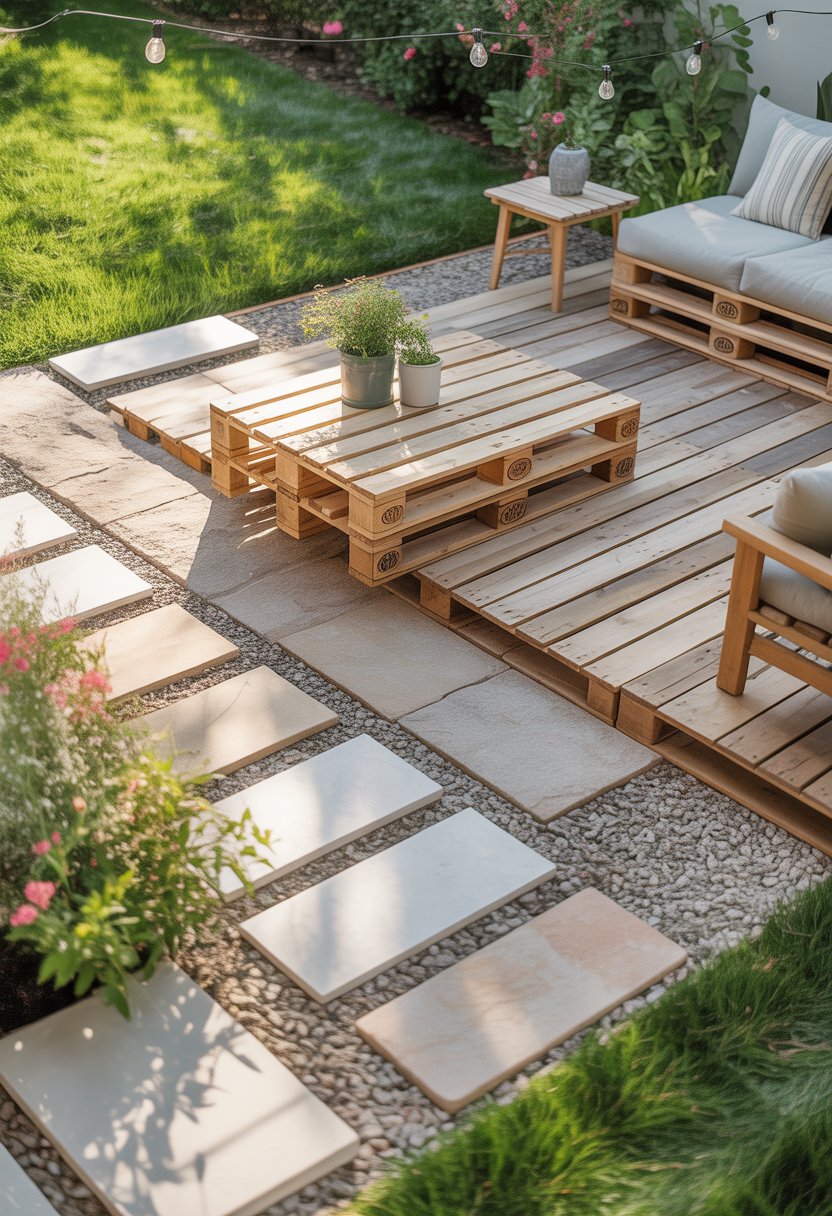
Affordable outdoor flooring can look good while standing up to the weather. The right choice depends on where you plan to use it and the surface underneath.
Waterproof
If your patio or balcony gets wet often, waterproof flooring is important. Vinyl deck tiles are a solid option because they snap together quickly and keep water from soaking through. You can install them yourself without glue or nails.
Rubber mats also work well for wet areas. They are durable, slip-resistant, and easy to clean. You can cut them to fit any space. Plastic deck tiles are another low-cost choice. Many of these tiles come in colors and patterns, so they can add a fun look.
Pros:
- Easy installation
- Water-resistant
- Budget-friendly
Cons:
- Not as soft as grass
- May get hot in direct sunlight
Over Dirt
Installing flooring over dirt is simple and doesn’t need much prep work. Interlocking deck tiles made from wood or composite material are a popular choice. You can lay them right on top of the ground. If the area is uneven, add a sand base first to even things out.
Outdoor carpet is another cheap idea. It can go over dirt and provides a soft surface for walking. Make sure the carpet is made for outdoor use to resist moisture and mold.
Gravel is an affordable and fast option. Spread it over the dirt for better drainage and a natural look. Use a weed barrier beneath to stop weeds from popping up.
Suggestions:
- Use treated lumber for wood tiles
- Choose UV-resistant outdoor carpets
- Lay a liner under gravel
Over Concrete
Concrete can look dull, but you can cover it without spending much. Peel-and-stick vinyl tiles work well for patios and porches. They stick to concrete and come in different colors.
Outdoor rugs are another quick fix. They’re cheap, easy to move, and add some color. Rubber pavers protect the concrete below and make it more comfortable to walk on.
For a natural touch, install artificial grass over concrete. You only need adhesive or tape to secure it in place.
| Flooring Type | Cost | Ease of Install |
|---|---|---|
| Vinyl Tiles | Low | Easy |
| Outdoor Rugs | Low | Very Easy |
| Rubber Pavers | Moderate | Easy |
| Artificial Grass | Moderate | Moderate |
Over Grass
You can create an outdoor living space even on your lawn. Portable deck tiles can be set directly over grass. Look for tiles made from plastic or composite, as they resist moisture and mold.
Outdoor area rugs are another simple solution. Choose rugs labeled for outdoor use so they won’t fade or get ruined by rain. For events, roll out snap-together flooring panels to create a sturdy walking surface.
Wooden pallets are a cheap and creative idea. Lay them side by side to form a small deck. Sand the pallets to prevent splinters and use outdoor paint for a fun finish.
Quick Tips:
- Pick tiles with drainage holes
- Anchor rugs to prevent sliding
- Treat wood with weather-resistant sealant
Terrace Flooring Ideas Outdoor
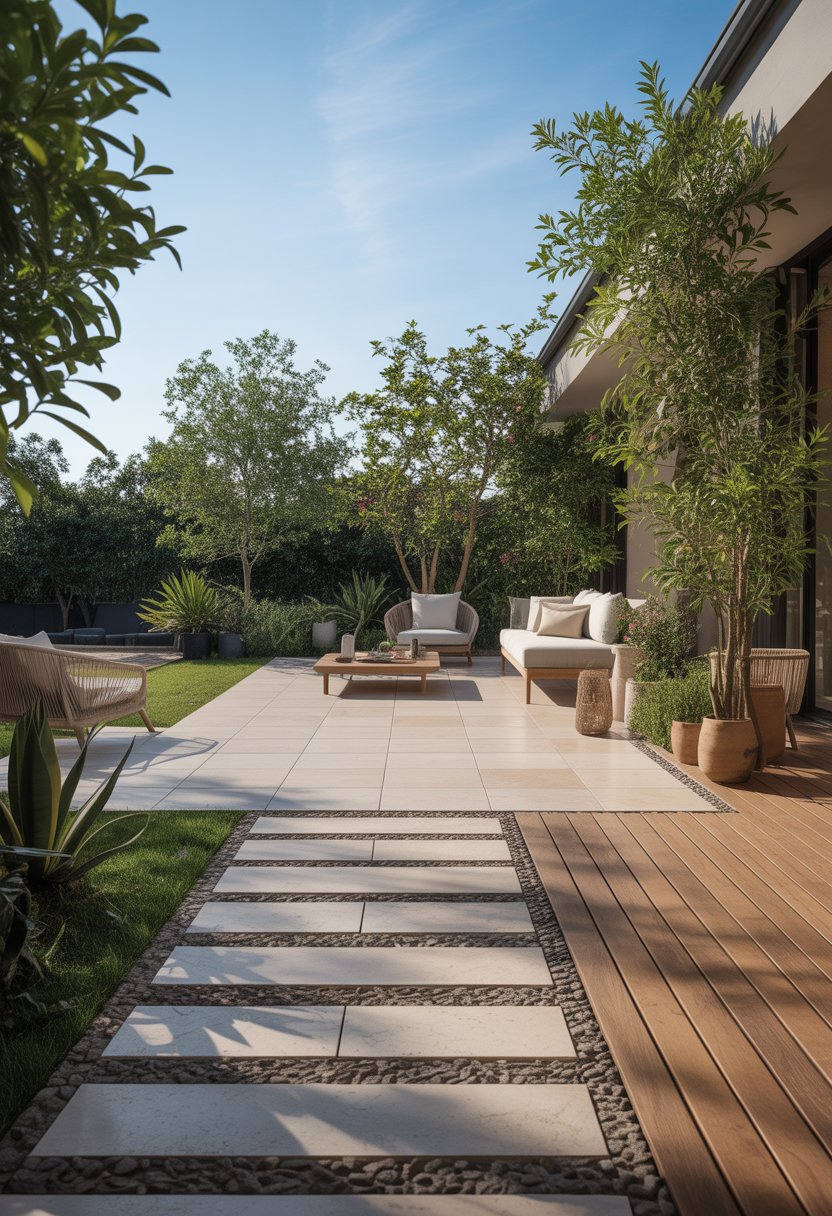
Choosing the right terrace flooring can make your space feel larger, safer, and more stylish. Different options work best depending on the space you have and what you want to use it for.
Small Terrace Flooring Ideas
For small terraces, space is precious, and you want flooring that will not overwhelm the area. Interlocking deck tiles are a popular pick because they are easy to install and can be cut to fit tight spaces. These tiles often come in wood or composite, which makes them durable for outdoor use.
Gravel is another good choice, allowing water to drain and helping to prevent puddles. You can also choose outdoor rugs made from weather-resistant materials for a soft surface.
If you want a garden feel, artificial grass can provide green color without the upkeep. Use lighter colors or simple patterns to help open up the space. Modular flooring options are also easy to change out if you want a different look later.
Roof Terrace Flooring Options
A roof terrace often gets a lot of sun and wind, so flooring here needs to be tough. Composite decking is popular because it can handle strong sun and rain while staying cool underfoot.
You might also like porcelain tiles. They are easy to clean, come in many styles, and do not get slippery easily. Rubber tiles are another smart option—they offer comfort, are safe for kids, and absorb noise.
Some people use outdoor carpet, which adds warmth and is easy to roll out. Natural stone slabs, like slate or granite, give a nice look but may need sealing to last in tough weather. Always check your roof’s weight limit before adding heavy floors.
Outdoor Rubber Flooring
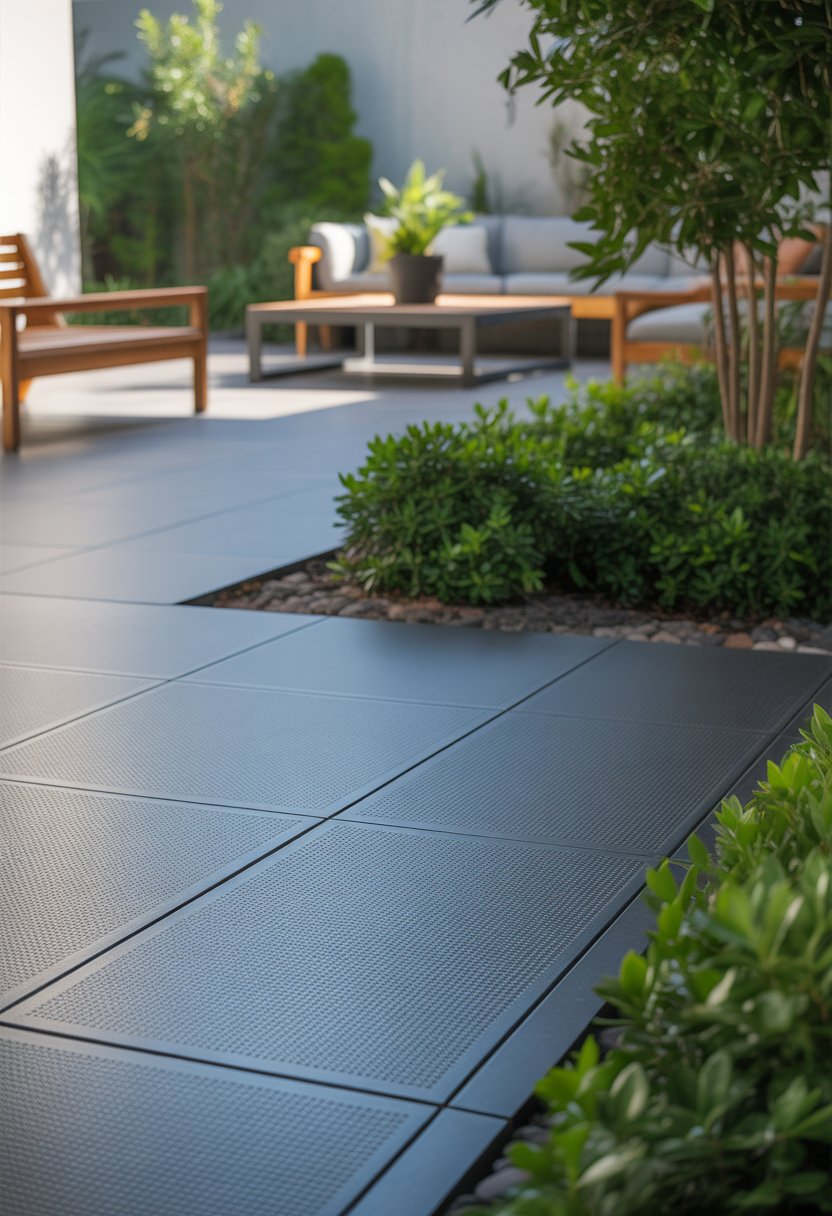
Rubber flooring is durable and slip-resistant, making it safe for patios, decks, and play areas. It’s waterproof, easy to clean, and stays comfortable even during hot or rainy days.
Interlocking Rubber Tiles
Interlocking rubber tiles are square or rectangular pieces that fit together like a puzzle. You can install them without glue, so they’re easy to remove or replace if one gets damaged. The tiles come in different thicknesses, colors, and textures. Some feel soft, while others have a firmer grip.
These tiles are popular for play areas and gyms because they absorb shock and protect against falls. They work well on concrete, wood, or packed dirt. Cleaning is simple—just sweep or rinse with water.
Pros:
- Quick to install
- Customizable design
- Easy to move or replace
Cons:
- Edges may shift if not locked snugly
- Gaps can collect dirt
Interlocking tiles are best if you want a DIY project that doesn’t need glue or nails.
Outdoor Rubber Flooring Rolls
Rubber flooring rolls come in large sheets. You unroll them to create a smooth, seamless surface. They are great for covering wide spaces like patios, walkways, or pool areas. Because there are few seams, water doesn’t leak through as easily.
These rolls are usually thicker than tiles and offer more protection from rough ground. They also dampen sound and are comfortable to walk or run on. You may need glue or double-sided tape for a more permanent setup.
Benefits:
- Fewer seams for a smoother look
- Good for large areas
- Cushions impact
Things to consider:
- Heavier and harder to move alone
- Harder to trim to size without tools
Rubber rolls work best if you want a long-lasting, sturdy surface.
Pallet Flooring Outdoor

Pallet flooring is a budget-friendly way to transform your patio or backyard. You can pick between classic wood or newer vinyl options for different looks and strengths.
Wood Pallet Flooring Outdoor
Wood pallet flooring is made from reclaimed wooden pallets. You can often get these for free or cheap from local stores. Wood pallets let you build a rustic floor where the wood’s natural grain shows.
To use them, you’ll need to sand the boards and check for nails. Sealing the wood will help protect it from rain and sun. This makes the floor last longer and keeps it looking good.
Install pallets directly over dirt or gravel but use a weed barrier underneath. This keeps grass from growing up through the floor.
Here’s a quick list of pros and cons:
| Pros | Cons |
|---|---|
| Cheap or free | Needs sealing |
| Easy to find | Can rot or warp |
| Rustic appearance | Not as durable as vinyl |
Vinyl Pallet Flooring Outdoor
Vinyl pallet flooring is a newer choice. It uses vinyl planks with a pallet pattern or look. This floor is more water-resistant than wood, so it works well in wet climates.
Vinyl planks often snap together, making installation easy. You can set them on a flat, hard surface, like a deck or concrete slab. Many vinyl products are also non-slip, which is safer for families with kids.
They come in several colors and styles. You get the look of wood with less work. Vinyl is also easier to clean—just hose it off or sweep.
Keep in mind, vinyl costs more than wood pallets. However, you may save on maintenance and repairs.
Terrazzo Flooring Outdoor
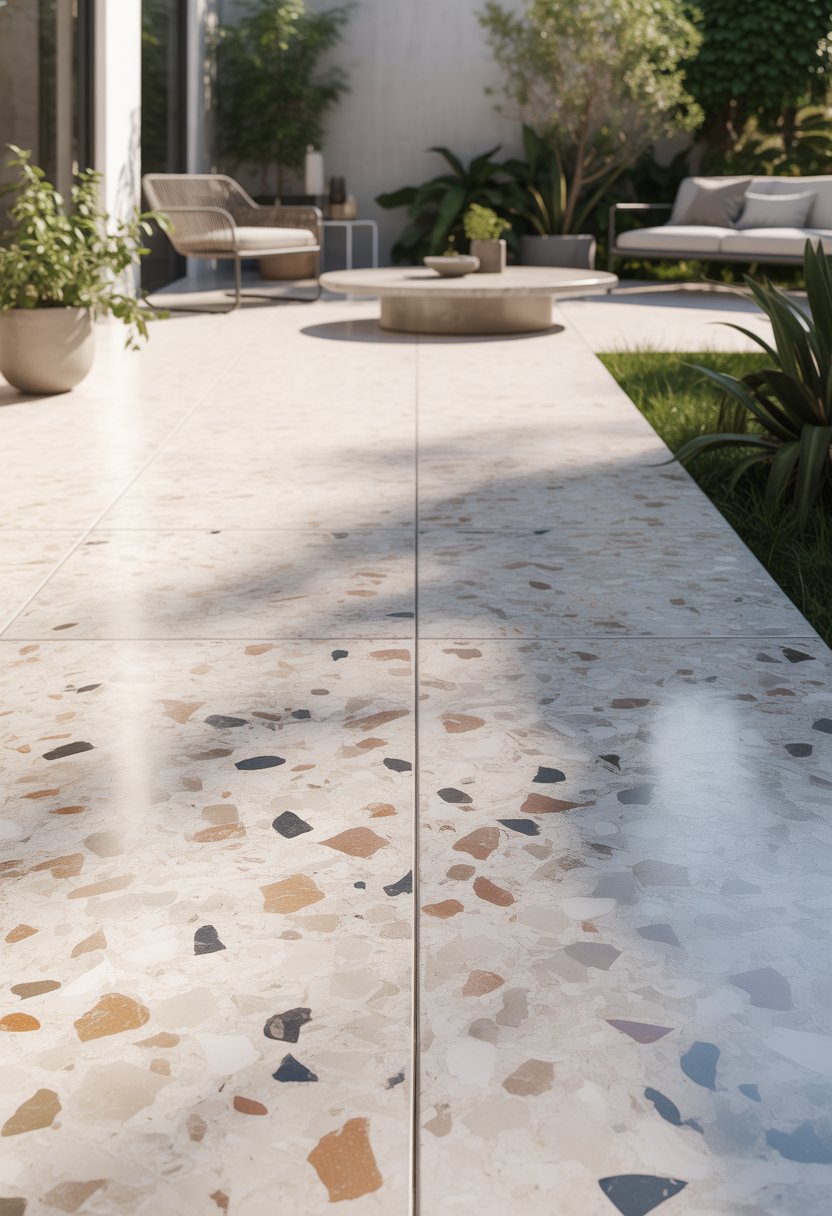
Terrazzo is a stylish choice for outdoor flooring. It is made by combining small pieces of marble, glass, or stone with cement. The surface is polished to create a smooth, speckled look.
You can pick from many colors and patterns with terrazzo. This lets you match it with your patio furniture or garden style. Terrazzo is also very durable and holds up well against sun and rain.
Here are some key points about terrazzo for outdoor spaces:
| Benefit | Details |
|---|---|
| Easy to clean | Just sweep or hose it off |
| Customizable | Choose different colors and chips |
| Weather resistant | Handles rain and strong sunlight |
| Slip-resistant | Non-slip options are available |
Pros:
- Unique look
- Low maintenance
- Works in both modern and classic designs
Cons:
- Can crack if not installed carefully
- May need sealing over time
If you want a playful and modern touch for your outdoor space, you might enjoy terrazzo flooring. It is both practical and decorative.
Stone Flooring Outdoor
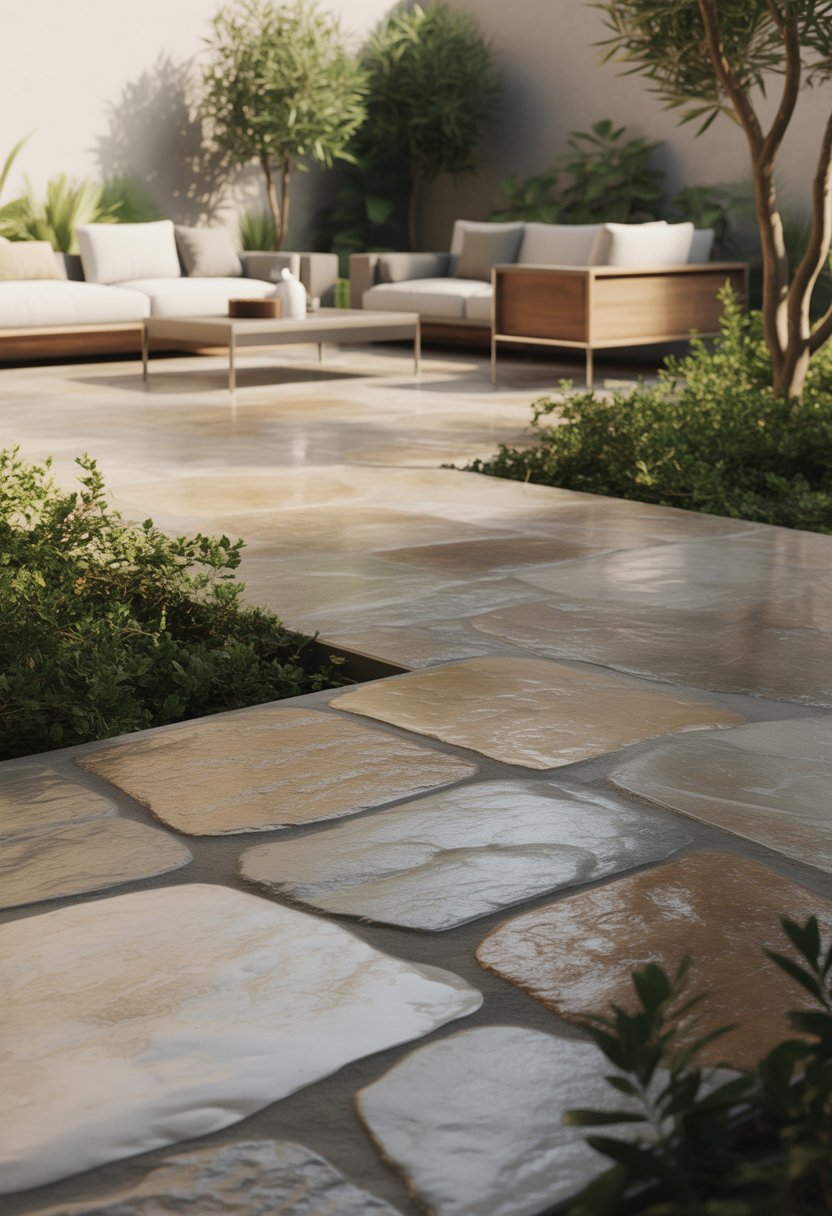
Stone flooring is an attractive choice for your yard, patio, or walkway. You will find options in natural stone, manufactured tiles, and other interesting materials with different care needs, price points, and looks.
Natural Stone Flooring Outdoor
Natural stone works well outside because it is tough and looks nice. Stones like slate, flagstone, and limestone are popular for patios and garden paths. These stones do not get too hot in the sun and hold up well in rain and snow.
You can cut natural stone into different shapes, making it easy to fit odd spaces. Note that natural stone needs sealing once or twice a year to protect it from stains and weather. Some types can be slippery, so choose a textured stone for steps or pool areas.
Common natural stones and their features:
| Stone Type | Color Range | Slip Resistance | Upkeep |
|---|---|---|---|
| Slate | Greys, blacks | Moderate | Medium |
| Flagstone | Earth tones | Good | Low |
| Limestone | Soft creams | Moderate | Medium |
Outdoor Stone Tile Over Concrete
Stone tiles can update a concrete patio or walkway. They come in many patterns and colors. Installing them over concrete creates a sturdy, level surface that handles foot traffic well.
You must ensure the old concrete is clean and even before laying the tiles. Use an outdoor-rated tile adhesive and grout to prevent damage from rain or freezing. Some stone tiles will need sealing every year.
Popular choices for stone tile include granite, quartzite, and travertine. These materials handle the weather and look more polished than rough-cut stone.
Important tips:
- Sweep and rinse stone tile regularly.
- Fill cracks quickly to avoid water getting underneath.
- Stick to lighter-colored tiles in hot, sunny areas.
Pebble Flooring Outdoor
Pebble flooring uses smooth stones set in mortar or resin. It creates a textured look that is perfect for garden paths, patios, and shower areas. This flooring is slip-resistant, so it works well around pools or outdoor showers.
You can choose from mixed river pebbles or single-color stones for a more organized look. Pebble flooring is easy to clean; just hose it down as needed. Over time, you might need to refill loose stones or reseal the surface.
You can even use pebble mats for simple DIY projects. Just lay them out and lock them together over existing surfaces.
Why pick pebble flooring?
- Natural feel underfoot
- Good drainage
- Less heat buildup
Bricks Flooring Outdoor
Brick flooring gives your outdoor space a timeless style. Bricks can be arranged in patterns like herringbone, basket weave, or running bond. This flooring holds up well to rain and constant use.
It’s best to set bricks over a gravel or sand base, which helps with drainage and keeps them from cracking as the ground moves. For a more permanent finish, use mortar between the bricks.
Brick can be slippery when wet, so choose rough brick or add a textured surface if you want more grip. Clean with a broom and power washer. Weed can grow between the gaps, so expect a little extra care to keep things neat.
Key features:
- Classic looks
- Easy to repair individual bricks
- Good for large terraces and walkways
Outdoor Vinyl Flooring
Outdoor vinyl flooring mimics the look of stone, wood, or tile but is made from durable plastic. It’s designed to handle rain, sun, and heavy foot traffic.
Vinyl comes in planks or tiles that click together or stick down. Some styles are waterproof and non-slip, so you can use them on patios, decks, and even pool surrounds.
Installation is fast. You can place vinyl over most existing floors, including concrete or old tile. It is softer underfoot than real stone and needs less upkeep since you only need to sweep and mop it.
Pros of outdoor vinyl flooring:
- Low price compared to real stone
- Wide range of patterns
- Resistant to fading and cracking
What Type Of Outdoor Flooring Should You Choose?
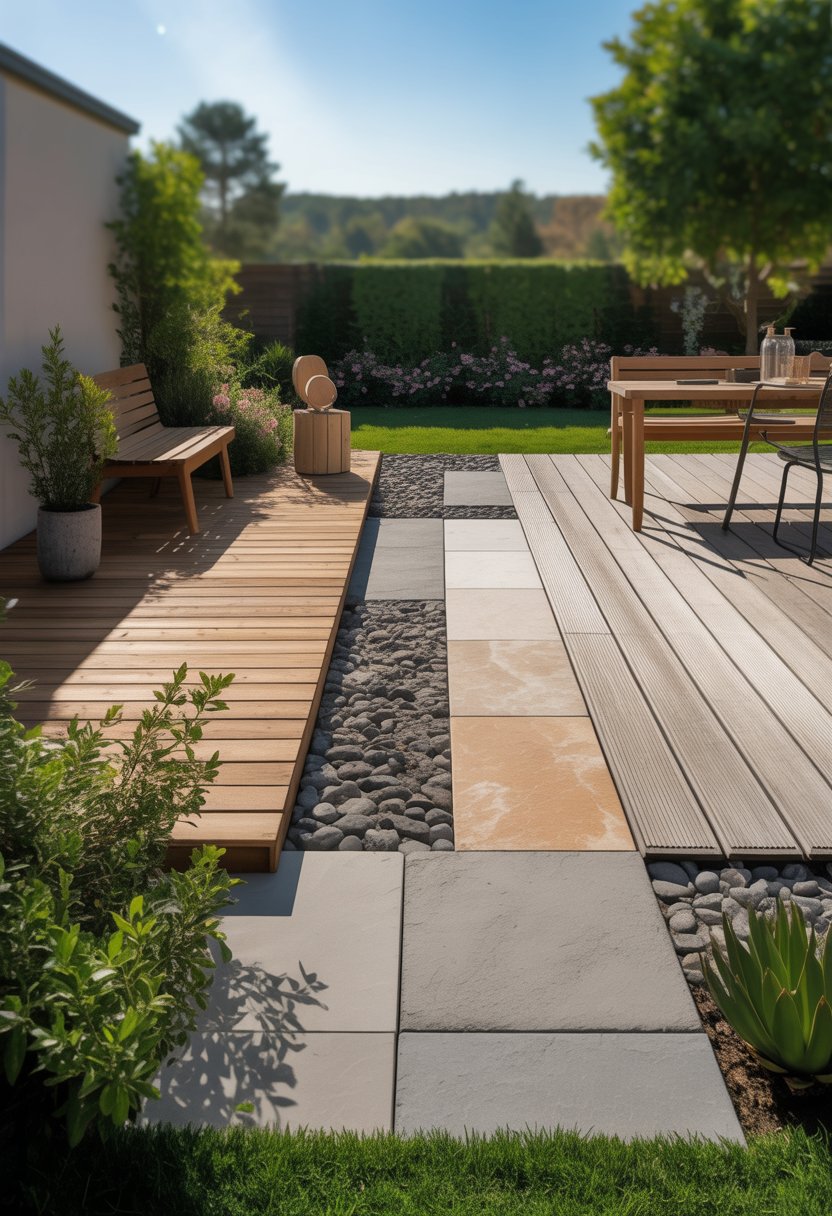
Choosing outdoor flooring depends on your needs, style, and budget. Some options are better for certain uses or climates. Here are a few popular choices to help you decide:
1. Concrete
Durable, low maintenance, modern look.
2. Wood Decking
Warm feel, natural style, needs sealing or staining.
3. Pavers
Comes in brick, stone, or concrete. Easy to replace pieces if needed.
4. Natural Stone
Elegant, weather-resistant, usually more expensive.
Here’s a table to make it easier:
| Flooring Type | Pros | Cons |
|---|---|---|
| Concrete | Strong, easy care | Can crack, plain look |
| Wood Decking | Classic, comfy on feet | Needs care, can rot |
| Pavers | Many styles, fixable | Weed growth, cost |
| Natural Stone | Fancy look, lasts long | Heavy, pricey |
Ask yourself a few questions:
- Do I want something easy to clean?
- Will it get wet or see lots of sun?
- What fits the look of my house?
If you have kids or pets, think about slips and comfort. Some surfaces get hot fast, like stone or concrete. Wood is softer, but can splinter over time. Always check if the surface is safe to walk on barefoot.
Pick what works for your space and how you use it. Each type has its own look and feel, so take some time to look at pictures or samples before you decide.
